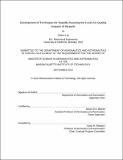Development of techniques for rapidly assessing the local air quality impacts of airports
Author(s)
Lee, Gideon (Gideon Luther)
DownloadFull printable version (8.180Mb)
Other Contributors
Massachusetts Institute of Technology. Dept. of Aeronautics and Astronautics.
Advisor
Steven R.H. Barrett.
Terms of use
Metadata
Show full item recordAbstract
The combustion of fossil fuels for aviation activity harms air quality and human health near airports through the production of PM2.5. Currently, dispersion models can assess these local-scale (distances ~10 km) impacts, calculating long-term (annual) average concentrations of PM2.5. However, these models typically require hours to complete an analysis for one site, hindering their use for assessing local-scale impacts over national or global extents. In this thesis, approximations are used to develop and apply the Rapid Dispersion Modeling System (RDMS) for calculating annual average concentrations of PM2.5. RDMS accuracy and speed were compared to a preexisting dispersion model, the AMS-EPA Regulatory Model (AERMOD). Meteorological, emissions, runway, and taxiway/terminal data for simulations were obtained from various sources. The RDMS was applied to obtain local-scale PM2.5 concentrations and exposures for the year 2006 for 191 U.S. airports that accounted for 95% of U.S. air passenger traffic. The resulting local-scale PM2.5 concentrations were combined with results from the Community Multiscale Air Quality (CMAQ) regional-scale model to account for primary and secondary PM2.5. Cases accounting for both landing-takeoff (LTO)-only and full-flight emissions were considered. Finally, premature mortalities at both regional and local scales were estimated by applying a concentration-response function to the combined concentrations. On average, RDMS over-predicts AERMOD concentrations by ~5% but reduces total simulation time by ~99.5% when only the rapid dispersion calculation (RDC) is considered. Including the calculation of dispersion parameters required by the RDC, RDMS saves ~95% of the simulation time required by AERMOD. Over all airports at the local scale, RDMS-modeled concentrations of PM2.5 accounted for 38-66 premature mortalities, 43-65% of total local-scale premature mortalities for the LTO case and 8-13% for the full-flight case. At the regional scale, RDMS-modeled PM2.5 accounted for 34-50% of premature mortalities for the LTO case and 4-7% for the full-flight case. Inclusion of RDMS-modeled local-scale variations increased local-scale premature mortality estimates by 16-27% for the LTO case and 1-2% for the full-flight case. Inclusion of local-scale variations increased regional premature mortality estimates by 8-12% for the LTO case and 1% for the full-flight case.
Description
Thesis (S.M.)--Massachusetts Institute of Technology, Dept. of Aeronautics and Astronautics, 2012. Page 126 blank. Cataloged from department-submitted PDF version of thesis. This electronic version was submitted and approved by the author's academic department as part of an electronic thesis pilot project. The certified thesis is available in the Institute Archives and Special Collections. Includes bibliographical references (p. 87-94).
Date issued
2012Department
Massachusetts Institute of Technology. Department of Aeronautics and AstronauticsPublisher
Massachusetts Institute of Technology
Keywords
Aeronautics and Astronautics.